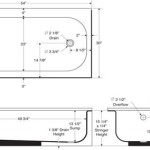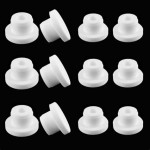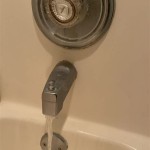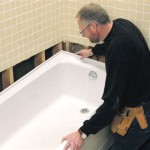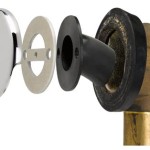What Is a Walk-In Bathtub?
A walk-in bathtub is a type of bathtub designed to provide a safer and more accessible bathing experience, particularly for individuals with mobility limitations, disabilities, or age-related challenges. Unlike traditional bathtubs that require stepping over a high threshold, walk-in bathtubs feature a watertight door that allows users to enter and exit the tub with ease. This design significantly reduces the risk of slips and falls, making bathing a more independent and comfortable activity.
These bathtubs are more than just a convenience; they are often viewed as a necessity for maintaining personal hygiene and overall well-being. The ability to bathe independently can have a profound impact on an individual's self-esteem and quality of life. Walk-in tubs can also assist caregivers by reducing the physical strain associated with assisting someone during bathing.
The construction of a walk-in bathtub incorporates several key features that contribute to its accessibility and safety. These include a low step-in threshold, a secure locking mechanism for the door, a built-in seat, grab bars, and often, therapeutic features like hydrotherapy jets. The overall design aims to minimize physical exertion and maximize comfort during the bathing process.
Key Feature 1: Accessibility and Safety
The primary advantage of a walk-in bathtub is its enhanced accessibility. The low step-in threshold, typically ranging from a few inches to no step at all, eliminates the need to lift one's legs high to enter the tub. This is a crucial feature for individuals with arthritis, joint pain, limited range of motion, or other conditions that make stepping over a traditional tub wall difficult or impossible. The reduced risk of falls significantly improves safety and provides peace of mind for both the user and their caregivers.
The watertight door is another critical safety component. It seals securely to prevent water leakage when the tub is filled. Many walk-in tubs feature a safety locking mechanism that prevents the door from being opened accidentally while the tub is full. The door is typically designed to open inwards or outwards, with each design offering specific advantages depending on the bathroom layout and user preference. Inward-swinging doors often improve water tightness, while outward-swinging doors can be advantageous in smaller spaces.
Most walk-in bathtubs include a built-in seat, usually positioned at a comfortable height for easy sitting and standing. This eliminates the need to lower oneself to the bottom of the tub, which can be challenging for individuals with weakened muscles or joint problems. The seat provides support and stability, allowing the user to relax and enjoy their bath in comfort.
Strategically placed grab bars are also essential safety features. These bars provide extra support and stability when entering, exiting, and maneuvering within the tub. They are typically mounted on the walls of the tub and designed to withstand significant weight. The placement and number of grab bars can vary depending on the model and the specific needs of the user.
Furthermore, some models incorporate slip-resistant surfaces on the tub floor and seat to further minimize the risk of falls. These surfaces provide additional traction, especially when the tub is wet. The combination of these safety features makes walk-in bathtubs a significantly safer alternative to traditional bathtubs for individuals with mobility concerns.
Key Feature 2: Therapeutic Benefits
Beyond accessibility and safety, many walk-in bathtubs offer therapeutic benefits through features like hydrotherapy jets and aromatherapy systems. These features can enhance the bathing experience and provide relief from various ailments.
Hydrotherapy involves the use of water pressure to massage the body and promote relaxation. Walk-in bathtubs with hydrotherapy jets typically have multiple jets strategically positioned to target key muscle groups. The jets can be adjusted for intensity and direction, allowing the user to customize their massage experience. Hydrotherapy can help relieve muscle tension, reduce pain, improve circulation, and promote overall well-being. It can be particularly beneficial for individuals with arthritis, fibromyalgia, or other conditions that cause chronic pain.
Some walk-in bathtubs also incorporate aromatherapy systems. These systems allow the user to add essential oils to the bathwater, creating a soothing and aromatic bathing experience. Aromatherapy can have a variety of therapeutic benefits, such as reducing stress, improving sleep quality, and boosting mood. Different essential oils have different properties, so users can choose oils that are specifically tailored to their needs.
Another therapeutic feature found in some walk-in tubs is chromatherapy, also known as light therapy. This involves the use of colored lights to stimulate the body's natural healing processes. Different colors are believed to have different effects on the body and mind. For example, blue light is often used to promote relaxation, while green light is associated with balance and harmony.
Microbubble therapy is another advanced feature gaining popularity in walk-in bathtubs. This technology infuses the water with billions of tiny, oxygen-rich bubbles. These microbubbles are said to penetrate the skin more effectively than regular bubbles, providing deeper cleansing and exfoliation. Microbubble therapy is also believed to promote circulation and improve skin health.
Key Feature 3: Installation and Considerations
Installing a walk-in bathtub requires careful planning and consideration of several factors, including bathroom space, plumbing requirements, and electrical needs. It is generally recommended to hire a professional installer to ensure that the installation is done correctly and safely.
Before purchasing a walk-in bathtub, it is essential to measure the available space in the bathroom. Walk-in tubs come in various sizes and shapes, so it is important to choose a model that will fit comfortably without obstructing other fixtures. It is also important to consider the placement of the door and ensure that there is enough clearance for it to swing open or closed. Some compact models are designed to fit in the same footprint as a standard bathtub, while others may require more space.
Plumbing requirements are another important consideration. Walk-in bathtubs typically require a dedicated water supply line and drain. The drain must be large enough to quickly empty the tub, as users must wait for the tub to drain completely before opening the door. Some models feature a fast-drain system to minimize waiting time. It is also important to ensure that the water heater is large enough to supply sufficient hot water to fill the tub.
Electrical needs should also be taken into account, particularly if the walk-in bathtub includes features like hydrotherapy jets or aromatherapy systems. These features require a dedicated electrical circuit. A licensed electrician should be consulted to ensure that the electrical system is adequate and that all wiring is done safely and according to code.
Beyond the technical aspects of installation, it is also important to consider the user's specific needs and preferences. Different walk-in bathtub models offer different features and benefits. It is helpful to consult with a healthcare professional or occupational therapist to determine which model is best suited for the individual's particular condition and mobility limitations. Factors to consider include the height of the seat, the placement of grab bars, the type of door (inward or outward swinging), and the availability of therapeutic features.
Finally, it's important to consider the long-term maintenance of a walk-in bathtub. Regular cleaning is necessary to prevent the build-up of soap scum and mildew. The door seal should also be inspected periodically to ensure that it is in good condition. With proper care and maintenance, a walk-in bathtub can provide years of safe and comfortable bathing.
Ultimately, understanding what a walk-in bathtub is encompasses recognizing its commitment to safety, accessibility, and therapeutic benefits for those facing mobility challenges. Choosing the right model requires careful consideration of space, plumbing, electrical requirements, and, most importantly, the individual's needs.

How Do You Get Out Of A Walk In Bathtub Ez Mobility Solutions

Walk In Bathtubs Simplicity Bath

Na 47 Inch Walk In Tub Quick Fill Whirlpool Bath Boundless

Two Seat Outward Swing Door Walk In Bathtub Little Rock Bath Makeover Of Arkansas
.jpg?strip=all)
ᐈ Aquatica Baby Boomer 2 Freestanding Solid Surface Walk In Bathtub Buy Best S

Best Walk In Tub Features For Seniors Kohler Bath

Ella S Bubbles The Companion Two Seat Inward Swing Door Acrylic Walk In Bathtub

Shak Acrylic Walk In Bathtub Little Rock Bath Makeover Of Arkansas

Handicap Walk In Bathtubs Accessible Bathroom

Walk In Bathtub What Are The Major Pros And Cons

